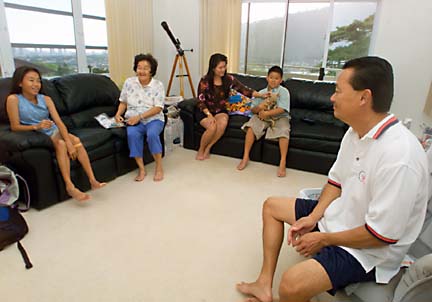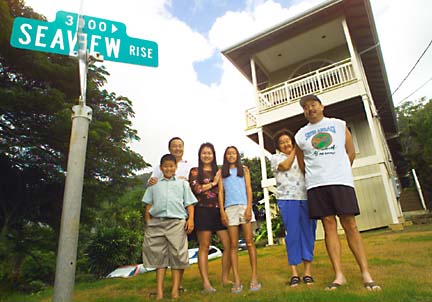
[ HOME FOR THE GENERATIONS ]

|
In the family
for 68 years
Stories about the Kunawai Lane
compound in Liliha have been passed
down from generation to generation
When Christopher Oakland, 8, and his sister, Lauren, 7, slip through the shrubbery to report in at grandpa and grandma's house next door and check out what's good to eat over there, they are walking in the footsteps of four earlier generations of their family.
The children are growing up in the Kunawai Lane compound that has been in the family for 68 years. They lived their really small-kid years in "atai's house," an 80-year-old wooden home their great-great-grandparents, Mun Kup and Mui Chun Yim Lai, bought in 1936.
Their mother's name for the old house refers to "atai," Chinese for great-grandmother. And Suzanne Chun Oakland talks about the old house with a mixture of nostalgia and relief. Only last year did she and husband Michael Oakland tear it down and build a two-story, five-bedroom home on the site. She kept a light fixture from the old, but "I sure am glad to finally have a dishwasher" in the new.
The other family home is "popo's house," where Violet Lai Chun, 87, lives with her son and daughter-in-law and their son, Randall Chun, 39.
One of the family tales about living close is told by Philip S. Chun, 69, a retired Kalihi YMCA executive. When he was courting Mei Chih Chung, the only telephone was in "atai's house." When she called him, an auntie would relay the message at the top of her voice across the yard, and "the whole neighborhood would know!"

|
Violet Chun remembers paying less than $3,000 for her house, which she and husband Shin Hoy Chun bought at the same time as her parents bought in the Liliha neighborhood. The two-bedroom houses had electricity. But what they didn't have in those good old days is the stuff of stories.
"The kitchen, a gas burner and no room to cook," she remembers. "The ice man delivered for the icebox, and the milk man delivered. A pig farmer came to collect buckets we'd hang out on the fence." It was an early recycling effort with the farmer collecting all kitchen waste.
Water had to be boiled on a wood fire outdoors to be safely consumed, and Philip was of an age to stack firewood.
If anyone has beaten a path between the two homes it is Violet Chun. Her mother was born in China and had bound feet. With her mother thus disabled, the cooking and chores of caring for eight younger siblings fell to the oldest daughter. She was her mother's caregiver for the last years of her life. "Atai" died in 1984 at age 97.
Both women were widowed in the 1940s, but life went on. Violet Chun worked at Honolulu Lithograph, varnishing labels for Libby and Dole canned products. Her sisters helped care for her sons Herbert and Philip. At any given time, there were two or three generations of Lais and Chuns in each house.
Violet Chun and her son replaced her old house with a four-bedroom home in 1959 with a good-size kitchen and three generations of convenience beyond the old house. "From icebox to ice maker," quipped her grandson, Randall, a graphic artist responsible for the computers in the house. He is the family historian, compiling a genealogy from federal immigration archives and collecting a shelf of old crusted bottles that surfaced when "atai's house" was demolished last year. His hard-times memory is about only having black-and-white television in his childhood, and his sister Suzie can top that: no TV at all in the early 1960s.
The houses are less than a block from Kunawai pond, one-time playground of the alii, which is now a shady public park. Philip takes his grandchildren there sometimes to catch crayfish. In his childhood, kids would take nets to catch big showy koi that escaped from a teahouse upstream, and he would catch frogs. Both were easy to sell to people planning to eat them.
One thing that has changed is that most of the mango, lichee, mountain apple and starfruit trees that typically surrounded a home two generations ago were cut to make room for more parking space and an easier lawn for working parents to tend.
A feature that remains is one of Violet's earliest efforts to keep her yard, on a downhill grade from the street, from turning into a mud patch. She had a low stone wall built that diverted the flowing rainwater, and it gives her satisfaction to this day that she spent that $100.
Randall points out that the heavy iron mesh topping on the wall is airport landing mat from World War II, a footprint of a broader history at the Chun compound.
[ OHANA HOME ]

|
In the Zone
A city ordinance lets families
expand their homesteads to set up
second homes to keep the ohana together
Kenn Murakami, 48, and his brother George, 45, still live with their mom. Thanks to "ohana zoning," their hillside house in Manoa also has room for George's wife and kids, plus Kenn's girlfriend.
On an island with limited space and an inclination toward extended families, ohana zoning allows relatives to stick together by attaching a second dwelling to their home. When you're raised in a prime neighborhood like Manoa, the Murakamis say, you tend to want to stay there even after growing up.
"I'm spoiled. That's why I'm living with my mom," said Kenn Murakami, a bar manager. "You can't beat the convenience."
His mother, Beatrice Murakami, 74, shares the main house upstairs with her son George, his wife, Sharon, and their two children. Kenn Murakami and Shari Asato live in the "ohana unit" downstairs, which has its own kitchen and gives them privacy as well as proximity.
The Murakamis decided to tear down the family homestead on Seaview Rise to build an expanded ohana version when that zoning option became available in Manoa 10 years ago. Extended family living comes naturally to Grandma Beatrice, who lived with her in-laws for 40 years, bridging cultural differences.
"It's a special kind of bonding," she said. "I wouldn't trade that for anything. I love to have my family with me. I hope they love to have me, too."

|
Everyone in the family looks out for each other. Grandma, an independent spirit, does most of the cooking for the upstairs household. She also does laundry when she has time between golf outings. Those are big plusses for George's family.
While the ohana unit is autonomous, sharing a house in the traditional fashion requires adjustment from everyone, on intergenerational differences over discipline and cleanliness, for example.
"There are challenges for all of us," said George Murakami, a financial planner.
"You should go into it knowing that you need to have a lot of patience and compromise," advised his wife, Sharon. "Everybody has to be open minded."
Ohana zoning was first adopted in Honolulu in 1982 as a way to allow for second housing units in neighborhoods that had sufficient infrastructure, such as sewers and roads. Homeowners soon began putting up elaborate second homes, and renting them out to non-relatives, violating the intent of the law.
In 1992, the ordinance was amended to specify that only family members can live in the dwellings and restricting the size of the ohana unit, according to Kathy Sokugawa, chief planner in the city's Department of Planning and Permitting. The second unit must be attached to the main house through a common wall, floor/ceiling, or the carport.
To find out whether your neighborhood is eligible for ohana zoning, call 523-4505, or see the ohana zoning map at http://gis.hicentral.com/website/parcelzoning/viewer.htm.